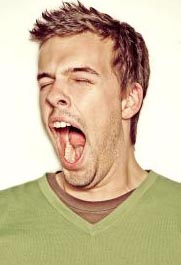Guess what? You may have a sleep disorder!
In the event you haven’t noticed, sales are booming in the sleep industry. The Fiscal Times projected U.S. consumers would spend $32.4 billion in 2012 on everything from pills, products, and medical devices to “sleep consultants” and mattresses. That number represents an 8.8 percent year-over-year increase since 2008.
 Most adults know someone (most likely themselves) who has a sleep disorder, probably obstructive sleep apnea (OSA)—the most common form of sleep-disordered breathing worldwide. OSA, characterized by repetitive partial or complete collapse of the upper airway passageway during sleep, causes impaired gas exchange in the lungs, subsequent gasping for air (however slight), and disrupted sleep. Sleep apnea affects an estimated 15 million adult Americans, and is the most common form of sleep-disordered breathing worldwide.
Most adults know someone (most likely themselves) who has a sleep disorder, probably obstructive sleep apnea (OSA)—the most common form of sleep-disordered breathing worldwide. OSA, characterized by repetitive partial or complete collapse of the upper airway passageway during sleep, causes impaired gas exchange in the lungs, subsequent gasping for air (however slight), and disrupted sleep. Sleep apnea affects an estimated 15 million adult Americans, and is the most common form of sleep-disordered breathing worldwide.
Experts estimate approximately 7 percent of adult men and 2-5 percent of adult women suffer from sleep apnea worldwide. The prevalence of sleep apnea is similar in both Caucasians and Asians, indicating it is common in both developed and developing countries. Overweight or obese individuals and elderly people are most likely to experience sleep apnea. In addition, some data suggest African-American ethnicity also may be a significant risk factor.
A sleep disorder (somnipathy) represents a serious medical condition that relates directly to negative health consequences, including an adverse cardiometabolic profile (diabetes, blood fat abnormalities), cardiovascular and cerebrovascular morbidity and mortality, mental and emotional afflictions, impaired work performance, anxiety, difficulties in personal relations, and last but not least, automobile accidents.
Types of Sleep Disorders
- Problems falling or staying asleep (insomnia). Episodes of insomnia may come and go, last for a few weeks, or be long-lasting (chronic insomnia).
- Problems staying awake (excessive daytime sleepiness). These disorders, termed hypersomnia, are generally not caused by lack of sleep or interrupted sleep. They are caused by a secondary medical condition like fibromyalgia and low thyroid function, mononucleosis or other viral illnesses, or overfatness (obesity). When no measurable cause can be noted this disorder is termed idiopathic hypersomnia.
- Problems sticking to a regular sleep schedule (sleep rhythm disorders). This condition often occurs among travelers switching time zones or shift workers with changing schedules.
- Unusual behavior during sleep (sleep-disordered behaviors). These disorders include obstructive sleep apnea, irregular sleep-wake syndrome, jet-lag syndrome, and paradoxical insomnia (the person sleeps a different amount than they think they do). Also included here are sleepwalkers and people who suffer from sleep terror (more common among children than adults).
Sleep disorders are serious
Sleep deprivation has been a significant factor in some of the mos t dramatic accidents recorded in recent history.Each year as many as 50,000 car accidents occur due to drowsy drivers as a side effect of untreated or undiagnosed sleep disorders. Since 1994 more than 20 laboratory studies have evaluated the effects of driving in a sleep-deprived state on one’s ability or safety. The data clearly show people with sleep disorders get in more accidents, often serious ones. The Exxon Valdez oil spill, the nuclear incidents at Chernobyl and Three Mile Island, and the explosion of the space shuttle Challenger were direct results of sleep-related problems.
Sleep disorders and increased cardiovascular disease
People who suffer from sleep apnea have an increased risk of cardiovascular disease, including heart attacks. If you are a male who regularly sleeps less than five hours per night, or a woman who regularly sleeps less than seven hours per night, you are two to three times more likely to have a heart attack. Furthermore, shift workers who are sleeping fewer hours, often poorly aligned to their natural circadian rhythm, also face a higher risk for cardiovascular disease. About 38,000 people die each year from stroke and heart attack due to sleep apnea. The medical cost of sleep apnea-related problems exceeds $1.9 billion per year.What explains this relationship between disordered sleep and risk of cardiovascular disease? Some researchers have speculated sleep loss (or disruption) can have an impact on inflammatory processes in the body. It is known that when we don’t sleep enough, blood levels of C-reactive protein, a marker of inflammation, increases. This underlying inflammatory process may damage the lining of blood vessels, making it more likely to develop atherosclerosis (a hardening and narrowing of the vessels) and ultimately heart attacks.
Risk factors for sleep apnea
 The major risk factors for sleep apnea include advanced age, gender (male), and obesity. Mechanisms proposed for the increased prevalence of sleep apnea in the elderly include increased deposition of fat in the neck area, lengthening of the soft palate of the mouth, and changes in body structures surrounding the throat. Why apnea is more common in men probably relates to increased fat deposition around the throat airway as compared with women, predisposing them to increased rates of obstructive apnea. Pre-menopausal women appear relatively protected from apnea, even if they have other known risk factors, most probably due to hormonal influences. Post-menopausal women show a four-fold higher prevalence of at least moderate apnea as compared with pre-menopausal women. Interestingly, in post-menopausal women taking hormonal replacement therapy, the prevalence of apnea resembles that of pre-menopausal women.
The major risk factors for sleep apnea include advanced age, gender (male), and obesity. Mechanisms proposed for the increased prevalence of sleep apnea in the elderly include increased deposition of fat in the neck area, lengthening of the soft palate of the mouth, and changes in body structures surrounding the throat. Why apnea is more common in men probably relates to increased fat deposition around the throat airway as compared with women, predisposing them to increased rates of obstructive apnea. Pre-menopausal women appear relatively protected from apnea, even if they have other known risk factors, most probably due to hormonal influences. Post-menopausal women show a four-fold higher prevalence of at least moderate apnea as compared with pre-menopausal women. Interestingly, in post-menopausal women taking hormonal replacement therapy, the prevalence of apnea resembles that of pre-menopausal women.
Overfatness, particularly increased abdominal fatness, represents a major risk factor for developing apnea and other sleep disorders. Increased upper-body fatness associates with anatomic alterations that predispose to upper airway obstruction during sleep.
Do you have a sleep disorder?
Most people with sleep disorders deny they have a problem, particularly men (it’s just not manly to admit to a problem). One’s sleeping partner, then, is the best person to consult about possible sleep apnea. The partner knows if the person is a loud and regular snorer and if they experience gasping or stop breathing during sleep. Often people with sleep apnea also experience restless leg syndrome—uncomfortable sensations in their legs and an irresistible urge to move their legs to relieve the sensations. The sensations are difficult to describe: They are an uncomfortable, “itchy,” “pins and needles,” or “creepy crawly” feeling in the legs. The sensations are usually worse at rest, especially when lying or sitting.
Also if you are a male with a neck circumference of 17 inches or more, or a women with a neck circumference of 16 inches or more, you are at high risk of having sleep apnea. The two simple tests that follow can be used to assess if you may have a sleep disorder. If you suspect you have sleep apnea or some other sleep disorder, contact your doctor for a referral for a sleep test from a qualified sleep lab.
Snore Score Test
- Are you a loud and/or regular snorer?
- Have you ever been observed to gasp or stop breathing during sleep?
- Do you feel tired or groggy upon awakening, or do you awaken with a headache?
- Are you often tired or fatigued during waking hours?
- Do you fall asleep sitting, reading, watching TV, or driving?
- Do you often have problems with memory or concentration?
If you answered YES to any of these questions, you are at higher risk for having obstructive sleep apnea. The risk increases even further if you are overweight, have a large neck, and/or have high blood pressure.
Sleepiness Scale Test
Use the following scale to rate how likely you are to doze during the following scenarios: 0=No chance of dozing; 1=Slight chance; 2=Moderate chance; 3=High chance
- Sitting and reading
- Sitting inactive in a public place (e.g. in a theater or a meeting)
- As a passenger in a car for an hour without a break
- Lying down to rest in the afternoon when circumstances permit
- Sitting and talking to someone
- Sitting quietly after a lunch without alcohol
- In a car, while stopped for a few minutes in traffic
- Lying down to rest in the afternoon when circumstances permit
Add the numbers for your final score:
0-9 Normal
10-12 Borderline
13-24 Abnormal
A number in the 10–24 range indicates one should seek expert medical advice. Scores of 11-15 are shown to indicate the possibility of mild to moderate sleep apnea. A score of 16 and above indicates the possibility of severe sleep apnea or narcolepsy.
References:
• Chami, H.A. 2013 “Vascular Inflammation and Sleep Disordered Breathing in a Community-based Cohort.” Sleep: 36(5):763-8.
• Durgan, D.J. 2012 “Cerebrovascular Consequences of Obstructive Sleep Apnea.” Journal of the American Heart Association: 1(4):e000091.
• Epstein, L.J. 2009 “Adult Obstructive Sleep Apnea Task Force of the American Academy of Sleep Medicine: Clinical Guideline for the Evaluation, Management, and Long-term Care of Obstructive Sleep Apnea in Adults.” Journal of Clinical Sleep Medicine: 5:263-276.
• Johns, M.W. 1991 “A New Method for Measuring Daytime Sleepiness: The Epworth Sleepiness Scale.” Sleep: Dec. 14(6):540-5.
• Lam, J.C.M. 2010 “Obstructive Sleep Apnea: Definitions, Epidemiology & Natural History.” Indian Journal of Medical Research: 131:165.
• Somers, V.K. 2008 An American Heart Association/American College of Cardiology Foundation Scientific Statement from the American Heart Association Council for High Blood Pressure in Collaboration with the National Heart, Lung, and Blood Institute National Center on Sleep Disorders Research (National Institutes of Health). Circulation: 118: 1080-1111.



mike fortuna
I’ve been using a CPAP and trying lose 10 pounds and playing a homemade Digeridoo to see if it helps with the sleep apnea. Heard about a Music School prof. at ASU doing a study on wind instrument musicians to see if they have less sleep apnea. Talked to several surgeons who didn’t think surgery would help.
Reply